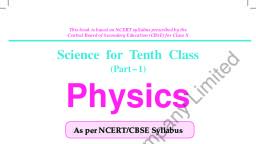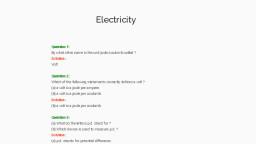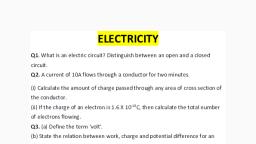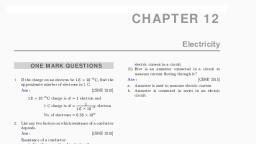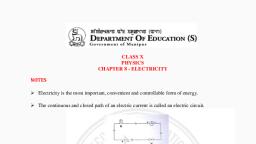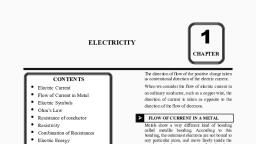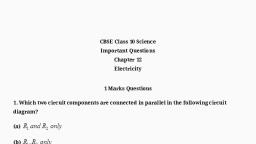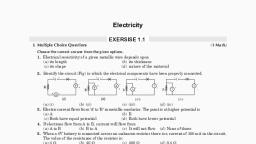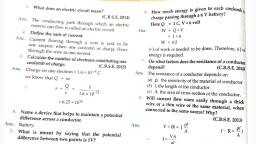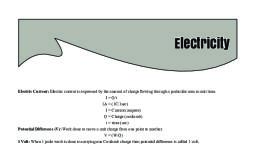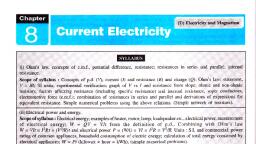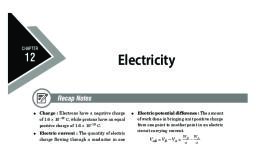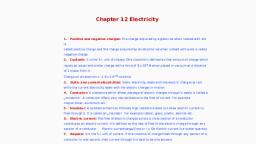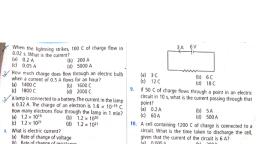Page 1 :
S h eikh Md . Ra biul Islam, , S.S.C PHYSICS, CHAPTER-10(Electric Current), , BS c ( Hon’s) in Physics, Kh ulna U niversity, Ph o ne No: 01775-809189, , Electric Current:, When two bodies of different potential are connected by a conducting wire then electrons flow from, the body of low potential to that of higher potential. This flow of electron continues until the potential, difference between the two bodies becomes zero. If by any process the potential difference between, the two objects is maintained, then this flow of electron goes on continuously. This continuous flow, of electrons is electric current., Definition:, The amount of charge that flows in unit time through any cross section of a conductor is called electric, current., Explanation:, If through any cross section of a conductor, the quantity of charge Q flows in time t, then the electric, current will be,, Q, I=, t, Unit:, The unit of electric current is ampere. Which is denoted by A., What do u mean by 1A ?, If an amount of charge 1 C flows in 1 second through any cross section of a conductor, then the quantity, of electric current produced is called 1 A., 1C, I = 1s = 1Cs −1 = 1A, What do u mean by 10A?, , Determine the amount of charge performed when 3A flow current flows, through a conductor for 12 minutes., If a 360 C charge flows through a resistor every two minutes, what will be its, electric current?, What is the potential difference between the two ends of a 7Ω resistor if a, charge of 350C per minute flows through the resistor?, The voltage difference between the two ends of a wire is 12V. The resistance of, the wire is 4Ω. How much charge will flow through the wire in 50 seconds?, Electromotive force or E.m.f:, Electrical energy is needed to produce electric current in a circuit. The electromotive force of an, electrical energy source is defined as the work done by the source or the energy spent by the source in, driving a unit positive charge from one point of the circuit to the same point by traversing the complete, circuit along with the source., If the work done is W J in bringing Q C of charge in a complete circuit, then the work done in bringing, W, 1 C of charge is . Therefor the electromotive force of a source is given by,, Q, , E=, , W, Q, , Unit:, The SI unit of electromotive force is JC −1 or volt (V).
Page 2 :
Potential difference:, The electricity flows through a conductor due to the potential difference between the two termina ls., The potential difference between any two points is defined as the amount of work done to carry unit, positive charge from one point to another of a circuit., If W is the amount of electrical energy converted to other forms for migration of Q amount of charge,, then the potential difference between the two points is,, W, V= Q, , Difference between Electromotive force and potential difference:, Electromotive Force, Potential Difference, 1. EMF is defined as the work done on a unit, charge., , 1. Potential difference is defined as the energy, which is dissipated as the unit charge pass through, the components., 2. EMF remains constant., 2. Potential difference is not constant., 3. EMF is independent of circuit resistance., 3. The potential difference depends on the, resistance between the two points during the, measurement., 4. Due to EMF, electric, magnetic, and the 4. Due to the potential difference, the only electric, gravitational field is caused., field is induced., 5. It is represented by E., 5. It is represented by V., , Conductor, insulator and semiconductor:, We know, electric current is the flow of charges through a material. This electric current can move, very easily through some substance. There are some mediums through which electricity cannot move, at all. Solid materials are classified into three groups depending on their electricity conduction .There, are,, 1. Conductor, 2. Insulator, 3. Semiconductor., Conductor:, The materials through which electric current can flow very easily are called conductors. Electrons can, flow freely within these materials. In metal wires the charges are carried by electrons. So, the metallic, materials are good conductors of electricity. Copper, silver, aluminium etc. are good conductors. Due, to this reason, metallic wires are used as electric connectors., Insulator:, The materials through which electric current cannot flow are called insulators. Therefore, the materia ls, where electrons are not free to move about are the insulators. For example: Plastic, rubber, wood, glass, etc. There are no free electrons inside insulating materials. Electrons do not flow easily through plastic, type materials. As a result plastics are insulator for electricity. Due to this, the handles of screwdrivers, and pliers used by electricians are covered with plastic type materials. In addition, the copper wires, which we use in our daily needs are covered with plastic., Semiconductor:, The materials whose current conduction capacity lies between that of conductors and insulators in, normal temperature are called semiconductors. For example- germanium, silicon etc. The current, conduction capacity of semiconductor can be increased by adding suitable impurities., Ohm’s Law:, The current passing through a conductor at constant temperature is directly proportional to the potential, difference between the two ends of the conductor.
Page 3 :
Explanation:, Let us consider, AB is a conducting wire. The potential of its two terminals are VA and VB, respectively. If VA >VB, The potential difference between the two terminals of the conductor will be, V = VA – VB., , Now at constant temperature, if the current passing through the conductor is I, then according to ohm’s, law,, I∝V, Or, I = GV-----------------------(i), Where G is the constant with is known as conductivity. And we know the conductivity is opposite to, the resistance. If the resistance denoted by R. The we can write,, 1, G=R, Input the value of G in equation (i) and we get,, V, I=, R, 1. A current of 4 A is flowing through the filament of the headlight of a motor car. If the potential, difference between the two ends of the filament is 12 V, what is the resistance of it?, Resistance:, The property of the conductor due to which its opposes a flow of current through it is called resistance., At particular temperature,, V, Resistance, R = I, =, , difference potential of two end, Electric current, , Unit:, The SI unit for resistance is ohm. It is expressed by the capital letter omega (Ω)., , Resistors:, A resistor is a conductor used in a circuit that has a known value of resistance. The main objective of, using resistors is to control the quantity of the current flowing in a circuit. There are two types of, resistors that are used in a circuit. These are:, 1. Fixed resistors, 2. Variable resistors, 1. Fixed resistors:, The fixed resistors are those who have fixed values of resistance. The fixed resistors that are generally, used in laboratory., 2. Variable Resistance:, The variable resistors are those whose value of the resistance can be changed according to the, necessity. These are called rheostat too. A rheostat is included in a circuit to vary the current flowing, through it., Dependence of resistance:, We know, when temperature and other physical conditions remain the same, the resistance of a, conductor is a constant. The resistance of a conductor depends on four factors. There are,, 1. Length of the conductor.
Page 4 :
2. Cross sectional area of the conductor., 3. Materials of the conductor and., 4. Temperature of the conductor., We know, if the temperature remains constant, the resistance of a conductor depends only on its length,, area of cross section and the material of the conductor. This dependence of resistance is expressed by, two laws. There are,, 1. Law of length, 2. Law of cross-section area, Law of length:, The resistance of a conductor is directly proportional to its length when the cross sectional area,, material and temperature of the conductor remain the same. If the length of the conductor is L, area of, cross section is A, and its resistance is R, then according to this law,, R ∝ L ------------------------(i), When temperature, material and A is constant., Law of cross-section area:, The resistance of a conductor is inversely proportional to its cross sectional area when the length,, material and temperature of the conductor remain the same. If the length of the conductor is L, area of, cross section is A, and its resistance is R, then according to this law,, 1, R ∝ A ------------------------(ii), When temperature, material and L is constant, Now, from the equation (i) and (ii) we can write,, L, R∝A, L, , Or, R = ρ A -------------------------(iii), Here ρ is a constant, the value of which depends on the material of the conductor and its temperature., This constant is called the resistivity or specific resistance of the material at that temperature., In equation (iii), if L=1 unit, A=1 unit, then,, ρ=R., Specific resistance:, The resistance of a conductor of unit length and unit cross sectional area is called the specific resistance, of that material at that temperature. The specific resistance is denoted by,, RA, ρ= L, Unit:, Substituting the units of the quantities on the right side of the equation, the unit of ρ is,, Ω𝑚2, , ρ= m, = Ωm, , Significance:, The resistivity of silver at 20 °C is 1.6×10-8 Ω m. Therefore, the resistance of a silver wire of length, 1m and cross sectional area of 1m2 is 1.6×10-8 Ω., Material, Specific resistance(Ωm), Silver, 1.6×10-8, Copper, 1.7×10-8, Nichrome, 100×10-8, Tungsten, 5.5×10-8, Electric Conductivity:
Page 5 :
The reciprocal quantity of resistance is called conductance. Like that, the reciprocal quantity of specific, resistance is called conductivity. Conductivity is expressed by the letter 𝜎. The value of 𝜎 depends on, the type of material of the conductor and its temperature., Let, the specific resistance of the material of a conductor = 𝜌, Therefore, the conductivity of its material is given by,, 1, 𝜎=𝜌, Unit:, The unit of 𝜎 is (𝛺𝑚)−1, Example:, The specific resistance of the Nichrome wire used in an electrical heater is 100 × 10−8 Ωm. What, will be the resistance of 15 m long wire having cross sectional area 2.0 × 10−7 m2?, Circuit:, The total path for transmitting electric current is known as circuit. There are two types of electric, circuit. There are,, 1. Series circuit, 2. Parallel circuit, Series circuit:, The circuit in which the electric components are connected one after another in a single loop is called, a series circuit., Parallel circuit:, The circuit in which the electric components are arranged in such a way that one terminal of all the, components are joined at a common point and the other terminal are joined at another common point, then this circuit is called a parallel circuit., Equivalent resistance:, If a single resistance is used instead of combination of resistances and if the current and potential, difference is not changed in the circuit, then that resistance is called the equivalent resistance of the, combination., Series combination of resistances:, Figure shows resistors R1 , R2 and R3 are connected in series. The resistances are connected one after, another successively. In this case, the same current I is flowing through each of the resistors. Now we, shall calculate the equivalent resistance of these three resistances those are connected in series., From Ohm’s law we get,, The potential difference across resistance R1 , V1 = IR1, The potential difference across resistance R2 , V2 = IR2, The potential difference across resistance R3 , V3 = IR3, If V is the potential difference between the two terminals, of all the resistors. The potential difference across the, combination, ∴ V=V1 +V2 +V3, = IR1 + IR1 + IR1, = I(R1 + R2 + R3 )------------------(i), Now if three resistances R1 , R2 and R3 are replaced by a single resistance Rs , so that same current I, flows through the circuit and the potential difference V across them remains unchanged, then Rs is the
Page 6 :
equivalent resistance of the combination. In case of equivalent resistance,, V = I Rs -------------------------------(ii), Comparing equations (i) & (ii) and we get,, I Rs= I(R1 + R2 + R3 ), Or, Rs= (R1 + R2 + R3 ) --------------------(iii), If instead of three resistances, n number of resistances are connected in series then, equivalent resistance Rs will be,, Rs= R1 + R2 + R3 +-----------Rn, Therefore, the equivalent resistance of resistors connected is series is equal to the sum of the differe nt, resistances included in the combination. The value of the equivalent resistance in series combinatio n, is greater than that of individual resistances., Parallel combination of resistances:, When several resistances are connected in such a way that one terminal of all the resistances are joined, at a common point A and the other terminals are joined at another common point B and potential, difference across each of the resistors remains the same, then this combination of resistances are called, parallel combination of resistances., Three resistors R1 , R2 and R3 are connected in a parallel combination. In this, case, same potential difference V is maintained across the two terminals of the, three resistors. Different amount of current is flowing through each of the, resistors owing to their different values. The main current I of the circuit splits, into three parts at the junction a and later recombine at the point b. Let I 1 , I2, and I3 are the currents flowing through the resistances R1 , R2 and R3, respectively. Therefore, sum of the currents I1 , I2 and I3 of parallel paths is, equal to the current I at the junction a. Therefore,, I = I1 +I2 +I3 ----------------------(i), Here, the potential difference between the two terminals being V, applying Ohm’s law, we get,, V, V, V, I1 = , I2 =, and I3 =, R1, , R2, , R3, , Substituting the values of I1 , I2 and I3 in equation (i) and we get,, V, V, V, I = + +, R1, , Or, I = V(, , R2, , 1, R1, , +, , R3, , 1, R2, , +, , 1, R3, , )-----------------------(ii), , Now if three resistances R1 , R2 and R3 are replaced by a single resistance Rp , so that same current I, flows through the circuit and the potential difference V across them remains unchanged, then RP is, the equivalent resistance of the combination., V, ∴ I = ---------------------------------------(iii), Rp, , Comparing equations (ii) & (iii) we get,, V, 1, 1, = V( + +, Rp, 1, , R1, , 1, , R2, , 1, , 1, R3, , ), , 1, , Or, R = R + R + R --------------------------(iv), p, , 1, , 2, , 3, , If instead of three resistances, n numbers of resistances are connected in parallel then the equivale nt, resistance RP can be expressed as,, 1, 1, 1, 1, 1, = + + +--------------------+ --------------------(v), Rp, , R1, , R2, , R3, , Rn, , That is, resistances connected in parallel combination, the sum of the inverse of the individ ua l, resistances is equal to the inverse of the equivalent resistance.


